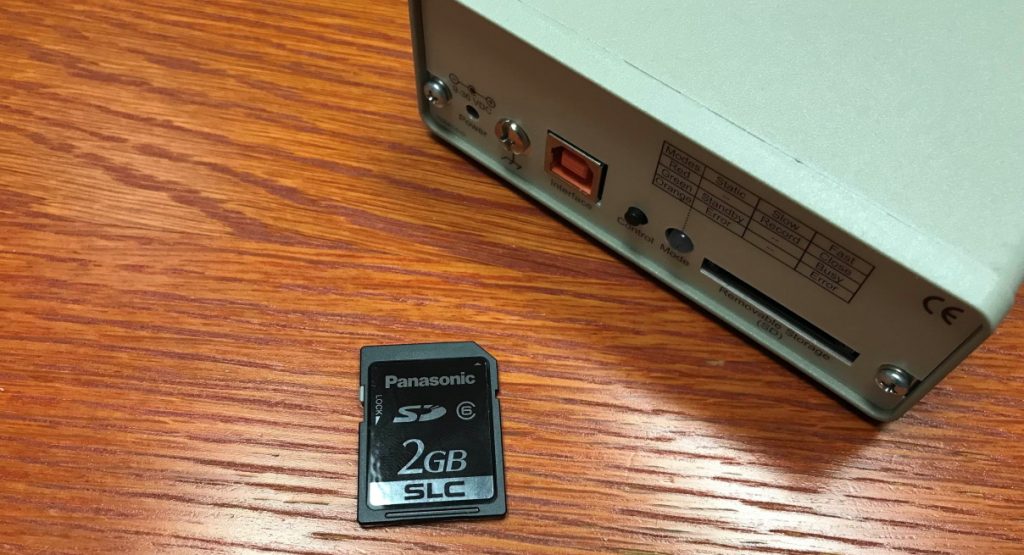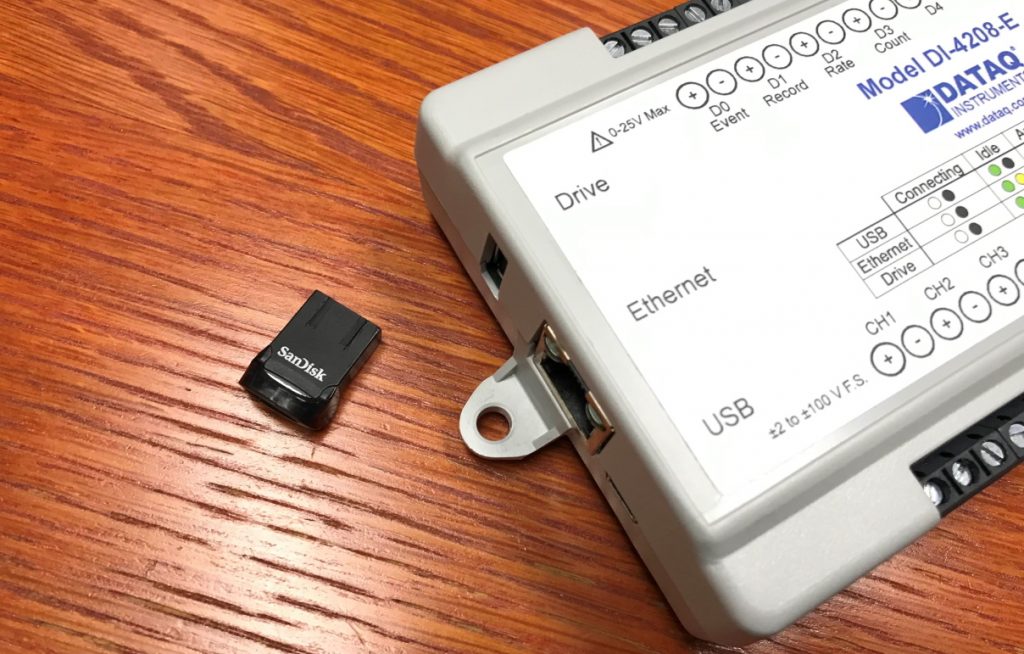For years, DATAQ has offered a number of different flash memory solutions for stand-alone data acquisition. Beginning with standard 2GB max capacity SD-style cards for older DI-710/718 series data loggers, progressing to the 32 GB thumb-style USB drives, included with contemporary DI-2000 and DI-4000 series instruments.
With maximum sample rates on the order of 14.4 kHz, DI-710, DI-718 and DI-718Bx-S series data loggers only allow for the use of standard SD cards (not SDHD or SDxC) with a maximum capacities of 2GB. The smaller memory capacity limits the total record time to a day or two at sample rates approaching the 14.4 kHz rate. In addition, 2GB SD memory cards are getting harder and harder to find.
As technology has progressed and maximum sample rates have increased to 160kHz, write speeds and memory capacity have increased as well.
The 32GB USB flash drive included with all contemporary DI-2000 and DI-4000 series data loggers allow for stand-alone sample rates in excess of 1,000 samples per second, per channel
Optional SLC high speed cards allow you to sample at throughput rates higher than 80 kHz.
Update Your Firmware
It’s important to note that the information contained in this post, especially as it relates to higher sample rates with a circular memory configuration, assumes that you have the latest firmware installed on your device.
You can download the latest firmware file for your particular data logger on our firmware upgarde page. Note that there are two categories, one for data loggers with a stand alone option (DI-2000 and DI-4000 series instruments), and one for data acquisition products without stand alone capability (DI-1000 series instruments).
You’ll find upgrade instructions at https://github.com/dataq-instruments/Firmware_Upgrade
Choosing the Appropriate Flash Drive
When choosing a flash drive for your application, there are a couple of important factors to consider.
The first thing to consider is sample rate. How often do you need to sample data? Assuming that you’re trying to display and record slow-changing signals or a general trend (temperature changes, flow rate or fluid level, for example), fast sample rates and high-speed flash memory cards are generally not required. Intended for application that require throughput sample rates less than 10 kHz, the 32GB USB flash drive that ships with all DI-2000 and DI-4000 series products (except for the DI-2008) would be sufficient for such applications.
For applications that require higher sample rates (on the order of 20 or higher throughput), an industrial-grade high capacity (32GB) or high speed SLC (up to 160K s/s, where last point mode is necessary for sample rates higher than 100K s/s) flash drive is recommended (see part #101014-32-HS & 101014-1-HS ). Higher sample rates would be needed to capture high frequency signals or rapidly occurring events, like voltage transients or impact data, for example.
Another important consideration when choosing a flash drive is the duration of your recording. How long do you need to acquire data while sampling a particular number of channels at a fixed sample rate?
Both the included USB drive that comes with DI-2000 and DI-4000 series data loggers, and the optional industrial grade high-capacity microSD card have a 32GB maximum capacity (part #101014-32-HS), while the optional industrial grade high-speed SLC microSD (part#101014-1-HS ) has 1GB capacity . To determine how long you can record (based on sample rate and the number of channels enabled), see our record time calculator at https://www.dataq.com/data-logger/features/calculator4000.html
While the Record Time Calculator gives you the total record time until the memory card is full, choosing Circular mode in stand alone setup allows you to record only the most recent data, using a first-in, first-out approach. With the Circular memory configuration selected, you could theoretically record forever.
For an explanation of the different memory configurations available in stand-alone mode, see our video tutorial on stand-alone setup at https://youtu.be/76_K7vyn_Yg.
Note that while you can use any USB flash drive, no two drives are created exactly the same. Consequently, we can only guarantee that the flash drives we carry on our website (and have tested extensively) will work as stated above. Note too that since the flash drive must be formatted in FAT32 format, a maximum capacity of 32GB or less is recommended (1GB – 32GB).
Additional Reading:
Stand-Alone Date/Time Stamps in Microsoft Excel
New Stand-alone Data Logging Features Added to the WinDaq Dashboard


 View Cart
View Cart sales@dataq.com
sales@dataq.com 330-668-1444
330-668-1444


2 Comments
Testo India
The information shared in the above article is very useful. This article is suitable for those people who want more information about Stand-alone Data Acquisition and Flash Memory.
Thank You for this article!
Agnisolar
Great Article, the information provided in the blog is excellent even; I was also aware of data acquisition, but after reading this blog, I came to knowledge about the Record Time Calculator, which gives the total record time until the memory card is full.
Thank you for this information. Keep sharing kind of blog in the future too.